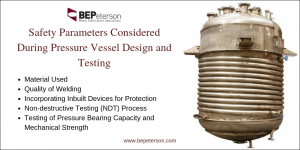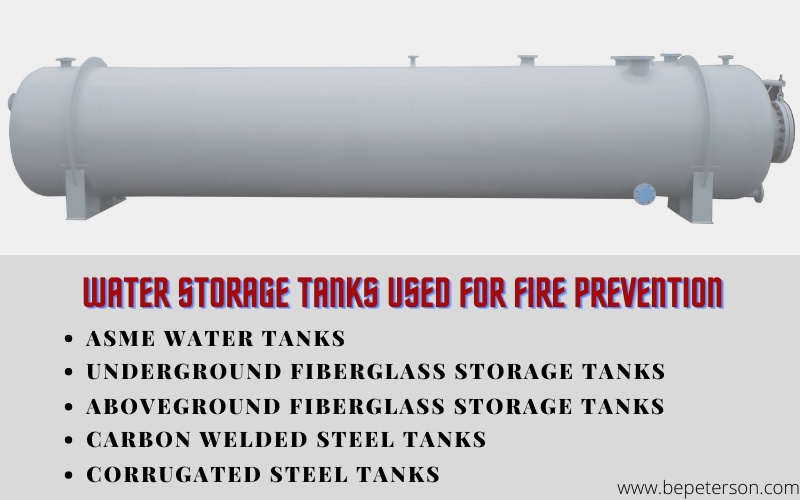It is common to find water tanks in several industrial and commercial facilities. These tanks are used for domestic, consumptive & commercial purposes. You can also find water tanks utilized for fire prevention. Now, you may enquire how these tanks differ from regular water storage tanks. The main answer lies in their design, mounting, and industry standards followed during their construction. All these aspects are briefly covered in this post.
Types of Water Storage Tanks Used for Fire Prevention
The following are a few common types of water storage tanks used for fire prevention.
Underground Fiberglass Storage Tanks
As the name indicates, these tanks are usually buried under the ground. They are designed in compact sizes, they consume less space and remain relatively safer than the above ground tanks. Fiberglass is a non-corrosive material and ensures the durability and reliability of any regular steel tank. These tanks can also be used for holding storm water, potable water, and so on.
Aboveground Fiberglass Storage Tanks and Stainless Steel Tanks
The above ground tanks made of fiberglass or stainless steel material are used for holding caustic water. These tanks may be built as dual purpose tanks, where the tank may be used for purposes such as storing potable water, rainwater harvesting, and so on, as well as fire extinguishing. Of these two types, stainless steel tanks are recommended by fire departments. Although plastic tanks are approved in many jurisdictions, they are mainly used for temporary fire protection during the construction phase.
Carbon Welded Steel Tanks
These tanks are made of carbon steel and are welded to improve their strength and durability. Unlike concrete tanks, carbon welded steel tanks do not experience Lyme leeching. Along with fire protection, these tanks are also used for storing wastewater, potable water, and so on.
ASME Water Tanks
These water storage tanks are designed for use in environmental conditions where they may be exposed to high temperatures or pressure. They are built to ASME specifications using materials like type 315, 304, and SA516 GR70 carbon steel.
Corrugated Steel Tanks
Made of corrugated steel, these tanks are available in any size and can store hundreds to millions of gallons.
Fire Protection Standards for Manufacturing and Installation of Water Storage Tanks
Most water storage tanks for fire prevention are designed according to the following industry standards:
- NFPA 22: This standard is regulated by NFPA, thus the name. The National Fire Protection Association (NFPA) is an organization that develops and disseminates consensus standards that helps minimize fire risks. NFPA 22 is the standard that specifically sets guidelines for the construction of water tanks used for fire protection. This standard does not recommend the use of tanks made of polyethylene or corrugated steel tanks fitted with removable plastic liners. However, many jurisdictions allow these tanks because they are cost effective. Having said that it doesn’t mean that these tanks cannot be used or that they neglect the NFPA standards. They must be used with precautions to avoid any chances of mishaps. This standard does not cover water tanks used for drafting into a fire truck. NFPA 22 also covers standards pertaining to fabrication and installation of dual service tanks, which are used for water protection as well as other purposes. These tanks must be built such that there is always adequate water supply to fight a fire. NFPA 22 also recommends the use of separate plumbing systems for residential use as well as fire protection.
- NFPA 13 D and 13 R: This is the standard for the installation of sprinkler systems. Of these, NFPA 13D covers the installation of sprinkler systems in manufactured homes and one- to two-family dwellings. However, NFPA 13R covers installation of sprinkler systems in residential homes up to 4 stories.
- Fire Department Standards: This standard covers the fire protection tanks used in residences. These tanks are usually referred to as drafting connection or even FDC or Fire Department Connection. Although the tanks may be built following the NFPA standards, here the connections are made according to the local fire department standards. Most Fire Department Standards recommend property owners to use 4″ pipe systems from the water tank. The pipe connection must be equipped with a shut off gate valve. The drafting connection specifications could be found out from your local fire department. Typically, National Hose Thread connections are used for the purpose.
- ASME: The American Society of Mechanical Engineers (ASME) is an organization that develops standards and codes covering engineering, installation, and maintenance of pressure vessels and boiler tanks. ASME water tanks are designed in adherence to ASME Code, Section VIII, Division 1 guidelines. The welding is made to ASME Section IX guidelines.
Safety Parameters Considered During Pressure Vessel Design and Testing

When designing, it is mandatory for pressure vessel manufacturers to stick to ASME vessel design guidelines for the safety of workers and the overall industrial unit. For end users of the vessels, it is important to ensure there are no cracks developed on the vessels after prolonged usage; this could lead to leakages and explosion. Hence, it is important to design a pressure vessel considering all the safety parameters:
- Material used: The material used for making a pressure boiler should be robust and not crack under pressure. Normally, they are made of carbon steel, nickel, stainless steel, 300 series & high temp SS, Inconel, aluminum, and more.
- Quality of welding: The quality of welding should be as per ASME standards mentioned in their section 8. Only welders who clear ASME P1-F3 are qualified to carry out the welding for such pressure vessels.
- Incorporating inbuilt devices for protection: This is a regular part of the pressure vessel design, which includes safety valves and vents in the design.
- Non-destructive testing (NDT) process: These non-destructive tests are carried out without disturbing the design. These include magnetic particle tests, ultrasonic, and radiographic tests.
- Testing of pressure bearing capacity and mechanical strength: It is crucial to test the mechanical strength of the pressure vessel and its pressure bearing capacity according to ASME standards.
Incorporating Fire and Explosion Safety Features in Pressure Vessels
Pressure vessels used across industries, and especially the ones designed to hold volatile liquids and chemicals, are equipped with a few safety features. This helps mitigate fire and explosion risks. Most of these features help the pressure vessel sustain a short fire without any damage. Here are some of the safety features:
- Steam gauges and valves: This is an inbuilt feature in the pressure vessel. Steam gauges help gauge the pressure of the steam within the vessel, whereas valves help release the pressure if it exceeds the preset limit.
- Fluid indicators: This is an inbuilt feature. This indicates the level of fluid in a vessel, thus preventing overflow and leaks.
- Pressure outlet valves: These are not internal like the steam valves but can be incorporated in the industrial facility to release excess pressure and avoid subsequent explosion.
- Fireproof insulation: This is an external feature, which helps reduce the spreading of fire and subsequent damage. The unit where pressure vessels are used has to be protected with fire insulation.
- Drainage vents: The industrial units where pressure vessels are used should have drainage vents.
- Water taps and sprinklers: This is a must in most industrial facilities as it mitigates the risk of fire in general. This may not be specific to only pressure vessels but can reduce the damage in case there is fire because of the pressure vessels or somewhere else in the premises.
- Emergency depressurization: This is an inbuilt feature in some pressure vessels used especially in industries such as oil & gas, chemical, and more, to mitigate the risk of fire and subsequent explosion.
As the roles played by water storage tanks in fire prevention are well introduced here, it is important that you source them from a trusted supplier. BEPeterson is one of the leading pressure vessel manufacturers and suppliers in the US. We are ISO 9001:2015 certified and comply with the ASME vessel design guidelines.

